by Kathleen Lawther
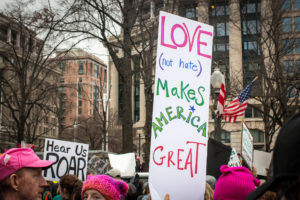 Following the Women’s March on Washington and the marches which took place around the world in solidarity on Saturday 21st January, I began to see posts popping up on Twitter and from the Museums Association in the UK highlighting the fact that museums wanted to collect protest signs, pink pussy hats and other artefacts relating to the marches. It’s great that museums want to document this moment and this movement, but I wonder if by the time museums have put out the message that they were collecting, it is already too late? Do people commonly bring their signs home with them? I didn’t personally attend a women’s march on the 21st but I have been to demonstrations before and I certainly didn’t lug any cumbersome signs home with me at the end of the day. They are not objects which are meant to last longer than a day or serve a purpose other than getting a specific message across at the specific time. This does not mean museums should not be collecting them, museums have always collected and preserved things which their makers never intended to last. But it does make the business of physically collecting them that much harder.
Following the Women’s March on Washington and the marches which took place around the world in solidarity on Saturday 21st January, I began to see posts popping up on Twitter and from the Museums Association in the UK highlighting the fact that museums wanted to collect protest signs, pink pussy hats and other artefacts relating to the marches. It’s great that museums want to document this moment and this movement, but I wonder if by the time museums have put out the message that they were collecting, it is already too late? Do people commonly bring their signs home with them? I didn’t personally attend a women’s march on the 21st but I have been to demonstrations before and I certainly didn’t lug any cumbersome signs home with me at the end of the day. They are not objects which are meant to last longer than a day or serve a purpose other than getting a specific message across at the specific time. This does not mean museums should not be collecting them, museums have always collected and preserved things which their makers never intended to last. But it does make the business of physically collecting them that much harder.
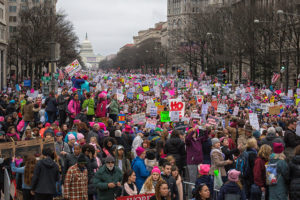 One of my concerns about museums putting a call out for signs after the fact is that the available signs are limited not only by the amount of people who will have bothered to take their signs home with them after the march, but by the amount of these people who will see these call outs and volunteer to donate their signs. This reduces the amount of available material to a tiny proportion of the millions of signs created for the day. It is therefore unlikely that museums will be able to pick and choose acquisitions which reflect the diversity of signs on the marches, from funny, light-hearted but pointed attacks on the new administration to signs highlighting the importance of intersectionality and making links to other movements such as black lives matter and LGBTQ (lesbian, gay, bisexual, transgender and queer) rights. You cannot encapsulate the breadth of these events in a pink pussy hat. Again, collecting specific items which stand for themes and events and using them to reflect on those themes is part of the everyday work in museums, but doing so at speed makes the process much harder. Social media also means that the people all over the world have already seen and shared images of the most thought-provoking, powerful and funny signs from the day, so if a museum is only able to collect a couple of items that don’t measure up to what has already been shared from the marches, people will know that what has been collected is not a true reflection of the protest.
One of my concerns about museums putting a call out for signs after the fact is that the available signs are limited not only by the amount of people who will have bothered to take their signs home with them after the march, but by the amount of these people who will see these call outs and volunteer to donate their signs. This reduces the amount of available material to a tiny proportion of the millions of signs created for the day. It is therefore unlikely that museums will be able to pick and choose acquisitions which reflect the diversity of signs on the marches, from funny, light-hearted but pointed attacks on the new administration to signs highlighting the importance of intersectionality and making links to other movements such as black lives matter and LGBTQ (lesbian, gay, bisexual, transgender and queer) rights. You cannot encapsulate the breadth of these events in a pink pussy hat. Again, collecting specific items which stand for themes and events and using them to reflect on those themes is part of the everyday work in museums, but doing so at speed makes the process much harder. Social media also means that the people all over the world have already seen and shared images of the most thought-provoking, powerful and funny signs from the day, so if a museum is only able to collect a couple of items that don’t measure up to what has already been shared from the marches, people will know that what has been collected is not a true reflection of the protest.
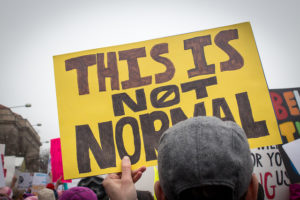 What is the solution to this? To be able to collect the best and most relevant objects from a protest, museum staff would need to be there at the event, either physically taking in objects on the spot, or at least handing out flyers with contact details and information about how to donate. Both of these approaches have their practical problems. To take in items there and then, museum staff would need to have entry forms on them, take the time to explain the donation procedure to protesters, and get them to sign the forms, all of which is taking up time in the day of someone who is there to take action, not record that action for posterity. By just handing out information, you place the burden on donors to take their sign home, keep it safe, and then bring it to the museum on a later date. A further option could be an alternative entry form designed for rapid response collecting, something quicker and easier to administer on the spot, which would allow museums to take in items with the minimum of fuss for donors and collectors, while upholding good documentation practice.
What is the solution to this? To be able to collect the best and most relevant objects from a protest, museum staff would need to be there at the event, either physically taking in objects on the spot, or at least handing out flyers with contact details and information about how to donate. Both of these approaches have their practical problems. To take in items there and then, museum staff would need to have entry forms on them, take the time to explain the donation procedure to protesters, and get them to sign the forms, all of which is taking up time in the day of someone who is there to take action, not record that action for posterity. By just handing out information, you place the burden on donors to take their sign home, keep it safe, and then bring it to the museum on a later date. A further option could be an alternative entry form designed for rapid response collecting, something quicker and easier to administer on the spot, which would allow museums to take in items with the minimum of fuss for donors and collectors, while upholding good documentation practice.
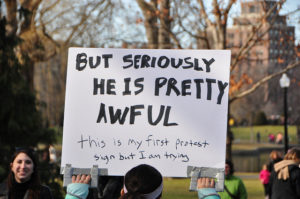 That is just the practical side of things. First a museum has to make a decision that an upcoming event will be significant enough to warrant on the spot collecting. It’s easy to say in hindsight that the Women’s March was significant and that items from the march should be preserved. But in the current climate protests are happening all the time, in quick reaction to new events. On 28th January people flooded the terminals of several US airports in protest at the executive order banning refugees, the following day spontaneous protests also happened in US cities. How can a museum as an institution react quick enough to be on the ground collecting at protests that erupt in multiple locations on a Saturday night? An individual member of staff could, perhaps, but would they be able to represent their museum in these circumstances without approval from their institution?
That is just the practical side of things. First a museum has to make a decision that an upcoming event will be significant enough to warrant on the spot collecting. It’s easy to say in hindsight that the Women’s March was significant and that items from the march should be preserved. But in the current climate protests are happening all the time, in quick reaction to new events. On 28th January people flooded the terminals of several US airports in protest at the executive order banning refugees, the following day spontaneous protests also happened in US cities. How can a museum as an institution react quick enough to be on the ground collecting at protests that erupt in multiple locations on a Saturday night? An individual member of staff could, perhaps, but would they be able to represent their museum in these circumstances without approval from their institution?
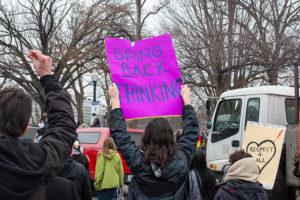 The other question this raises for me is whether it is ethical for a museum, or the representative of a museum, to attend a protest just to collect donations? A relevant parallel might be that of journalists and photographers, who attend protests as observers and recorders. In reacting to current events museums may have to act more like journalists, covering events with a detached eye. But museum staff and established museum practices for collecting are not prepared for this type of fieldwork. The protesters being asked to donate may be sceptical of museum workers being there in this context, especially if they believe the museum to be at odds with their cause, or taking a neutral and unhelpful stance on whatever they are protesting. There is something uncomfortable for me in the idea of a museum taking up space, and taking up people’s energy and time at a protest if the museum is ultimately only there to serve its own interests. Perhaps this will change in time if museums do take up a more active social role, as opposed to their more traditional role of collecting and recording.
The other question this raises for me is whether it is ethical for a museum, or the representative of a museum, to attend a protest just to collect donations? A relevant parallel might be that of journalists and photographers, who attend protests as observers and recorders. In reacting to current events museums may have to act more like journalists, covering events with a detached eye. But museum staff and established museum practices for collecting are not prepared for this type of fieldwork. The protesters being asked to donate may be sceptical of museum workers being there in this context, especially if they believe the museum to be at odds with their cause, or taking a neutral and unhelpful stance on whatever they are protesting. There is something uncomfortable for me in the idea of a museum taking up space, and taking up people’s energy and time at a protest if the museum is ultimately only there to serve its own interests. Perhaps this will change in time if museums do take up a more active social role, as opposed to their more traditional role of collecting and recording.
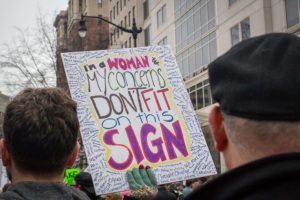 The answers to at least some of these questions come down to individual museums having a clear mission and a collecting policy which supports it, as well as robust collections management and documentation processes which can meet the needs of rapid response collecting. Museums have traditionally been reactive and they need to find ways to be more proactive. This might mean the staff who are usually responsible for approving new acquisitions taking the time to look ahead to upcoming local events which have the potential to produce interesting ephemera or other objects worth collecting, and assigning someone to go out and actively seek donations. It definitely means museums putting targeted policies and processes, like an on the spot temporary entry form, in place now if they want to be equipped to act quickly to what is happening around them. Like so many things it comes down to good collections management: museums really knowing their collections, and knowing what they want their collections to achieve.
The answers to at least some of these questions come down to individual museums having a clear mission and a collecting policy which supports it, as well as robust collections management and documentation processes which can meet the needs of rapid response collecting. Museums have traditionally been reactive and they need to find ways to be more proactive. This might mean the staff who are usually responsible for approving new acquisitions taking the time to look ahead to upcoming local events which have the potential to produce interesting ephemera or other objects worth collecting, and assigning someone to go out and actively seek donations. It definitely means museums putting targeted policies and processes, like an on the spot temporary entry form, in place now if they want to be equipped to act quickly to what is happening around them. Like so many things it comes down to good collections management: museums really knowing their collections, and knowing what they want their collections to achieve.
Kathleen Lawther is keeper of local history & archives at Hastings Museum & Art Gallery in South East England, and a freelance museum consultant with an interest in collections management, learning and engagement and the places where they intersect. She has worked in a range of organisations in the U.K. from small local authority museums to a national museum. She writes a personal blog about current issues in museums as acidfreeblog.com